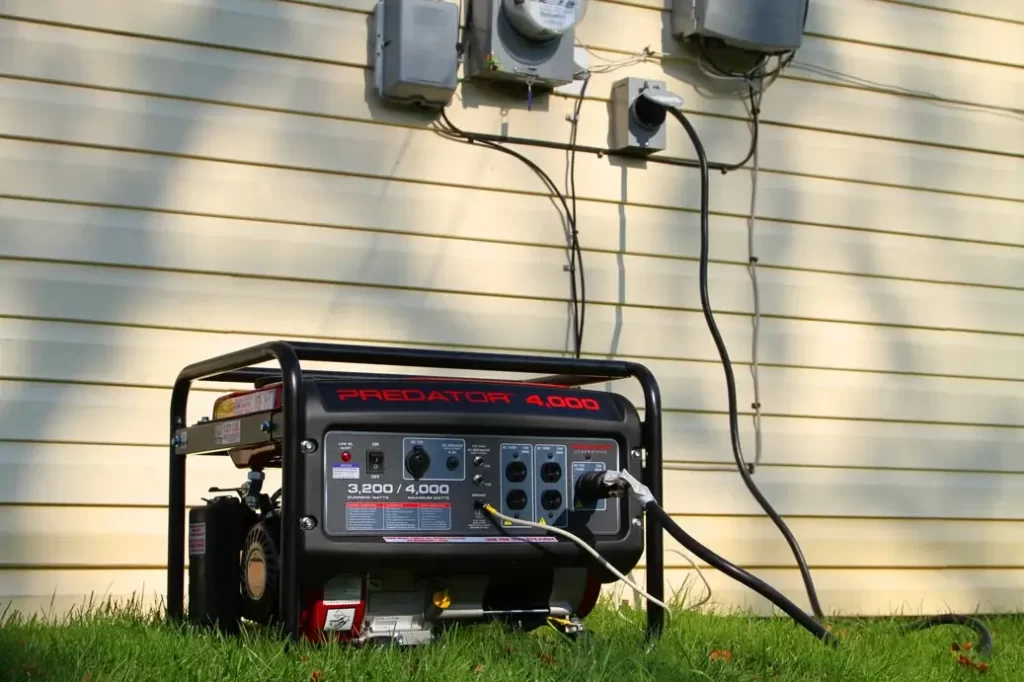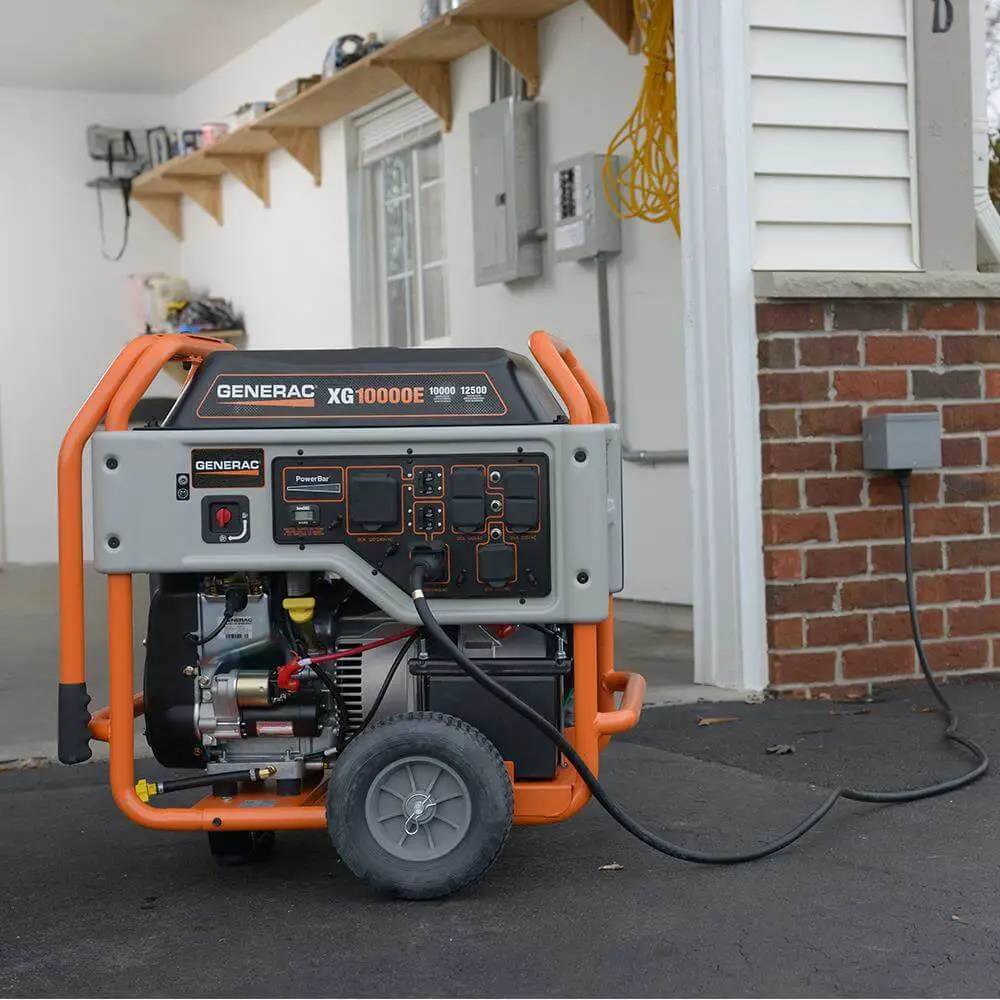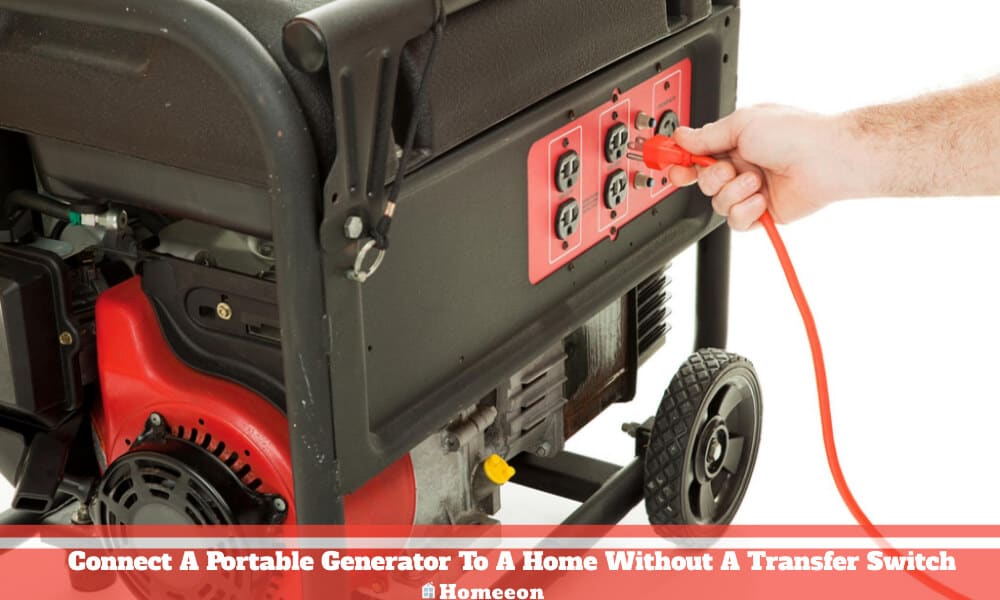Last Updated on August 5, 2023 By Emma W. Thomas
To connect a portable generator to a home without a transfer switch, use a heavy-duty extension cord to plug the generator into essential appliances directly. Prioritize safety, keep the generator outdoors, and avoid back-feeding to the grid.
Steps To Connect The Generator Without A Transfer Switch

While a transfer switch is vital to prevent damaging your electronic devices, you can still connect your generator without one and still be safe. Sometimes you may not have the funds required to purchase this vital tool. Worry not! The following steps will help;
Collect The Necessary Tools And Materials
You can never succeed with any electrical connections unless you have the right gear in place. Make sure that you have everything you need within reach and in the right safety measures. The following items are necessary for a successful installation process;
Interlock Kit
With this kit, you are sure to connect your generator safely without a transfer switch. There are many different interlock kits available, and you need to get one that matches your generator’s model. Get a specific kit for your version. These kits are readily available and also budget-friendly.
Connecting Wires
Depending on your property, you will need at least three sets of connecting (electric wires). You will need about ten feet of 10-gauge wires. You can choose to use different colors for quick identification while working.
Breaker
When choosing a breaker, it is advisable to pay attention to your type of generator. You also need to consider the specifications of your home. Look for a two-pole double breaker with a power of 30 amp as this will meet most specifications of a generator.
Safety Tools
It would be best if you were careful when dealing with electrical items to be safe when working. Ensure that you have safety gear such as gloves and protective eyewear. A good pair of work boots will also go a long way to protect you from electrocution.
Other Items
You will also want to collect other common tools such as wrenches, screwdrivers, pliers, chisels, electrical tape, and other electrical gears. These items will help to make the installation easy.
Consider The Amperage And Plug Type
For a successful installation, your generator needs to have a huge round plug to fit both sides of the breaker. You can find the amperage near the plug as well as some codes. Make sure that you read the codes well and adjust the materials as per these codes.
Drilling A Hole
You will need to drill a hole in your wall that is enough to pass the electric wires into the house. Make sure that the holes are big enough for the wires to pass through and also fit properly. You will also need to look for a spot that is not near your generator. Keep it as far as you can. If your walls are thick, use a drill hammer to make the holes.
Fixing The Elements
This last step is the most important as it involves doing a real job. It would help if you mounted the power inlet box at some distance from your home, away from the exterior wall. Make sure the hole is watertight and get the conduit and assemble it. Attach these elements properly using some glue to ensure they are safe.
The next step is to wire the generator inlet plug. Pull each wire separately from the conduit body and attach the plug. Avoid using a 0.75-inch insulation wire and tighten the ends properly using a screwdriver.
You will then need to prepare the breaker box and push all the wires into it. Make sure that you turn off the main breakers and branch well. Make enough room and place the wires on the spot at the upper right. Install the wires and breaker retainer, then complete the process by covering the breaker again.
Be careful with the wires and fix them properly. Attach the red wire to one terminal on the breaker and the black one to the other. Fix the white wire onto the common bond rail inside the box and the green one into the ground rail.
If you have a 2-wire home without a third wire in the outlet box, you can place the green wire to a common terminal in the open.
Tools You Need to Connect A Portable Generator To A Home Without A Transfer Switch
- Generator Interlock Kit:
A generator interlock kit is a crucial tool that ensures your generator and the utility power cannot be operated simultaneously. It acts as a mechanical barrier, preventing back-feeding and protecting utility workers. This kit typically includes an interlock device panel, breakers, and associated hardware. - Heavy-Duty Extension Cords:
Investing in heavy-duty, high-quality extension cords is vital for safely connecting your generator to various appliances in your home. Make sure the extension cords you choose are the appropriate length, gauge, and wattage capacity for your generator’s output. Opt for cords with built-in circuit breakers for added safety. - Twist-Lock Plugs and Receptacles:
To establish a secure and reliable connection, twist-lock plugs and receptacles are essential. These connectors ensure a tight and stable electrical connection between the generator and your appliances or power inlet box. Ensure that the plugs and receptacles are compatible with your generator’s specifications. - Grounding Rod and Clamps:
Proper grounding is critical for safety when running a portable generator. A grounding rod and clamps are used to establish a direct path for electrical current safely into the ground. Ensure the grounding rod is correctly installed, and the clamps are tightly attached to both the generator’s grounding point and the rod. - Wattage Meter:
To prevent overloading your generator, a wattage meter is invaluable. It helps you monitor the power consumption of various appliances and devices in your home. By understanding the wattage requirements, you can ensure that you distribute the load evenly and avoid damaging your generator or appliances. - Generator Cover:
Protecting your generator from harsh weather conditions is essential for its longevity. A generator cover shields it from rain, snow, dust, and debris. Look for a cover specifically designed for your generator model to ensure a snug and secure fit. - Velcro Straps and Cable Ties:
Tidying up and organizing the cables running from your generator to your appliances is vital for safety and convenience. Velcro straps and cable ties help secure and bundle the cords together, preventing any trip hazards and facilitating easy movement around your home.
Reasons Why You Need A Transfer Switch For Your Generator

You may not technically need a transfer switch in your home. However, there are various reasons why it is recommendable to install one in your home such as;
It Is A Requirement By NEC (National Electric Code)
According to the National Electric Code, it is a requirement that one must have a well-installed transfer switch when using a heavy-duty generator. You are not supposed to power electrical devices in your home without this gadget.
If you plan to sell your home in the future, this requirement is crucial. It may lead to violations of the code if not properly installed.
For Safe Connection Of The Generator To Your House
Extension wires can sometimes cause back feed which increases the risk of electrocution. If not properly fixed, the wires can also cause a fire that can destroy your property, and lead to injury, or even death.
Helps To Power Your Home In Case Of An Emergency
Most electrical appliances, such as furnaces, air conditioners, and water heaters, are hard-wired. Such devices cannot be connected using an extension cord. A transfer switch also helps you to avoid the struggle of connecting your generator via extension cords whenever there is a blackout. Powering your home also becomes easy and safe.
How Many Appliances and Devices Can I Use with a 3000 Watts Generator
When it comes to emergency power supply or outdoor activities, having a reliable generator is crucial. A 3000-watt generator is a popular choice due to its portability and adequate power output. But just how many appliances and devices can you run simultaneously with this type of generator? Let’s find out!
- Refrigerator (600-800 watts): Keeping your food fresh during a power outage is vital. Fortunately, a 3000-watt generator can easily handle running a standard refrigerator. Remember to check the wattage of your specific fridge model to ensure compatibility.
- Television (150-400 watts): Whether you want to catch up on your favorite shows or stay informed during a power outage, a 3000-watt generator will effortlessly power most modern TVs. LED or LCD TVs typically require less wattage than older plasma models.
- Laptop/Computer (50-300 watts): Remaining connected in our technology-driven world is essential. If you need to power up your laptop or desktop computer, a 3000-watt generator will comfortably handle the task. Remember to consider the wattage requirements of any additional peripherals, such as monitors or printers.
- Microwave (600-1200 watts): Heating up a quick meal or indulging a popcorn craving might be crucial during power outages. With a 3000-watt generator, you can run a standard countertop microwave, as long as it falls within the wattage range mentioned.
- Lights (10-100 watts): Ensuring proper illumination is important for safety and comfort. A 3000-watt generator will easily handle powering multiple light bulbs, allowing you to keep your surroundings well-lit during an outage.
- Fans (50-100 watts): Keeping cool in hot weather is a priority for many. A 3000-watt generator can comfortably power a couple of electric fans, providing some respite from the heat.
- Charging Electronics (5-100 watts): In today’s connected world, charging essential electronics like smartphones, tablets, or smartwatches is a necessity. A 3000-watt generator will easily handle charging multiple devices simultaneously, ensuring you stay connected.
Wrap Up
While it is possible to connect a generator to your house without a transfer switch, it has several risks associated with it. The technique will also limit the number of electrical appliances that you can power since most of them are hard-wired. You may also violate the National Electric Code if you plan to sell your property in the future.
If you must embrace this technique, it should only be short term or if it is an emergency as you wait to get an expert to install a transfer switch in your home.
References:
https://www.galvinpower.org/connect-generator-to-house/
https://midwestgeneratorsolutions.com/blog-post/how-can-i-connect-a-generator-to-my-house-without-a-transfer-switch/
Emma is a graduate of Domestic Science or Family and Consumer Sciences (Home Economics) from the University of Wisconsin. She has 7 years of experience Working with the strategic section of BestBuy and now writing full-time for Homeeon.
From Managing the Home, Interiors, Cleaning, and Exteriors to Gardening and everything about Making A Home Liveable – is her passion and this Homeeon is the result of this.
Emma loves decorating her home with the best stuff found online. She cares about quality over anything and writes reviews about them here in Homeeon. Get in touch with her over Pinterest.
Keep reading her blogs.

